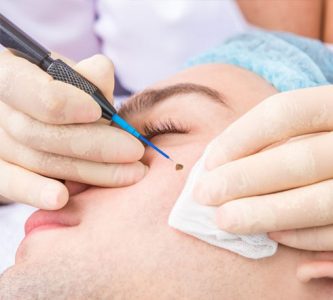Mole removal

There are many ways of mole removal, depending on the location and appearance of the mole.
Surgical Excision
Excision mole removal works by completely removing the mole by cutting it out, along with a small area of surrounding healthy tissue. This treatment is usually used to find out if the mole is cancerous and to ensure that the entire mole is excised down to its roots. The wound is then stitched up, and the mole is sent for histology analysis to confirm the diagnosis of a benign or cancerous mole.
Shave Excision
Certain types of protruding moles can be removed from the face and body using a shave excision technique which involves removing the mole at its base near the skin surface using a scalpel. The treated area may result in a small pink scar which should gradually fade with time.
Cryotherapy
Cryotherapy uses liquid nitrogen spray to freeze the tissue, causing the area to scab over. After about a few weeks, the scab containing the mole will fall off from the skin. This method is only used for certain types of protruding benign moles.
Laser Mole Removal or Electrosurgery
Laser or electrosurgery mole removal is best suited for smaller moles and is a good option when the mole is on the face as there is less risk of scarring.
DISCLAIMER:
The information written and published on this website is not intended to substitute the recommendations of a trained professional and does not replace a professional consultation.
It is advisable to undergo a formal consultation to help establish a relationship between the doctor and yourself, accurately determine your concerns/problems, and get the appropriate treatments for them.
It is also imperative to note that the contents of the website with respect to treatments, results and pricing can vary from individual to individual, and can only be accurately determined by the doctor upon diagnosis.
Do note that all medical treatments will only be administered upon proper consultation, with the requirement that patients be above 21 years of age to provide legal consent.
Surgical Dermatology
Meet your Dermatologist

Dr Tay Liang Kiat
Dermatologist
Dr Tay Liang Kiat is a fully accredited Dermatologist who specialises in skin cancers, Mohs micrographic surgery, dermatologic and nail surgery, aesthetic dermatology and laser procedures. With more than 20 years of clinical experience, he also manages other aspects of general ambulatory and inpatient dermatology, including eczema, psoriasis, acne, urticaria, hair loss, children skin issues and other complex medical dermatology. In addition, he has expertise in the use of the latest immunotherapy (biologics) treatment for severe eczema, psoriasis and urticaria.




